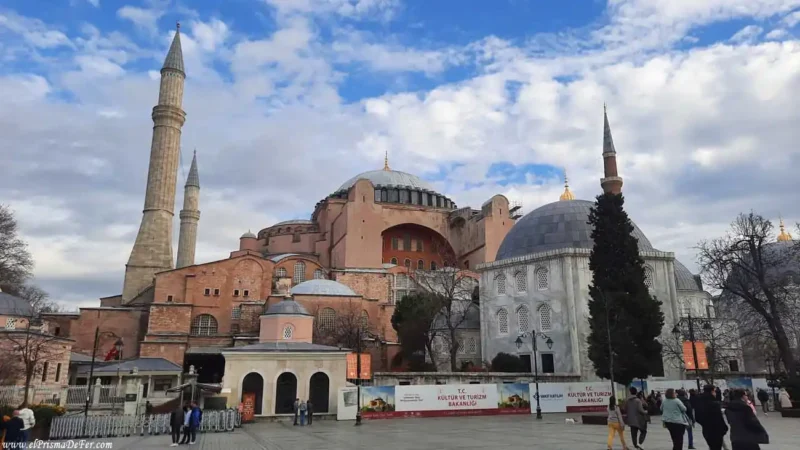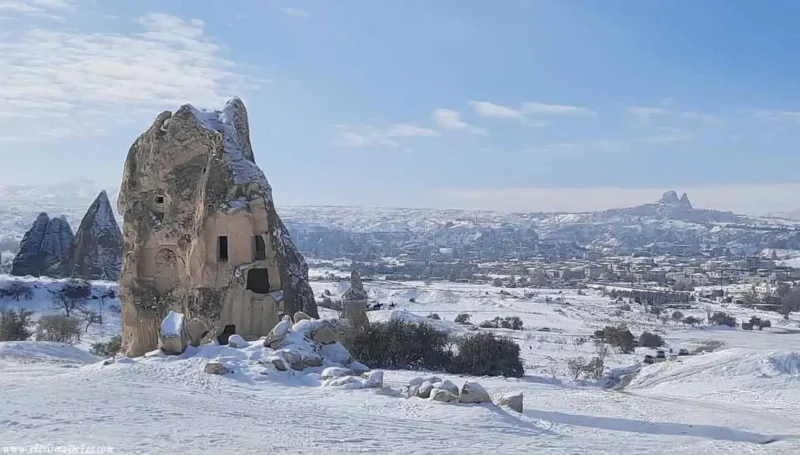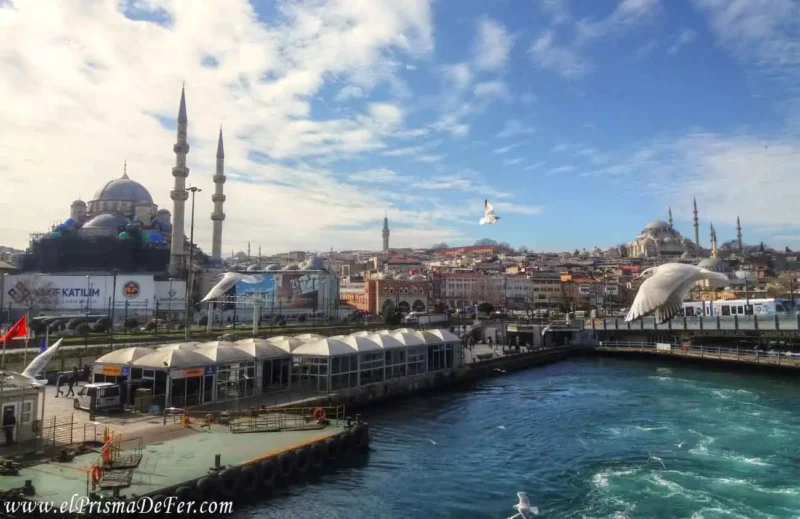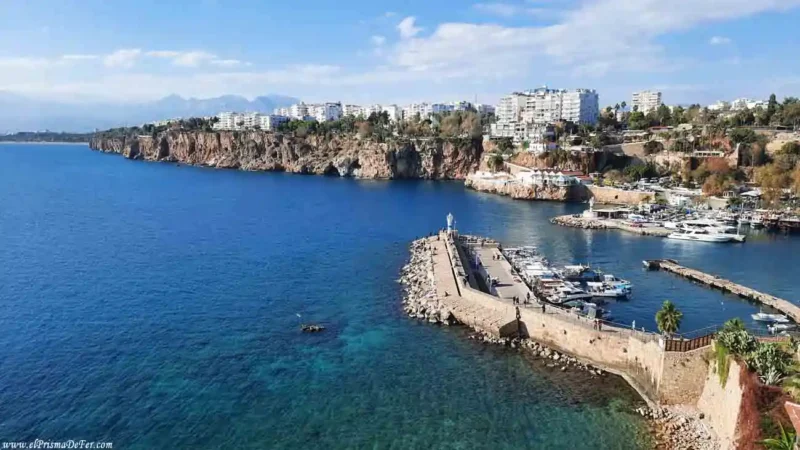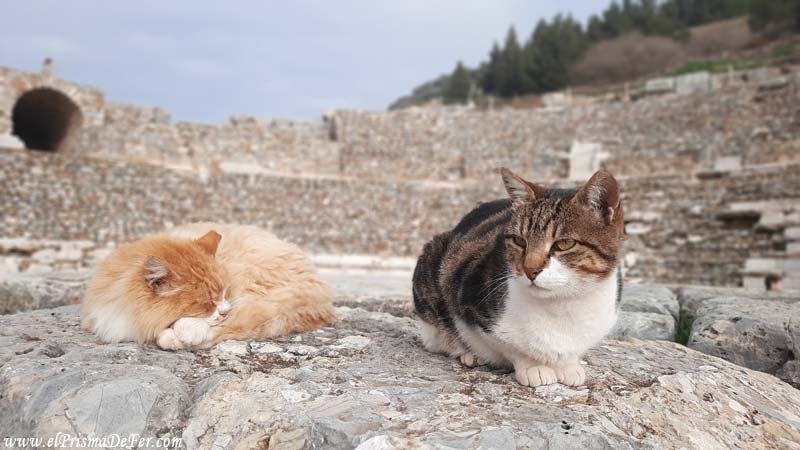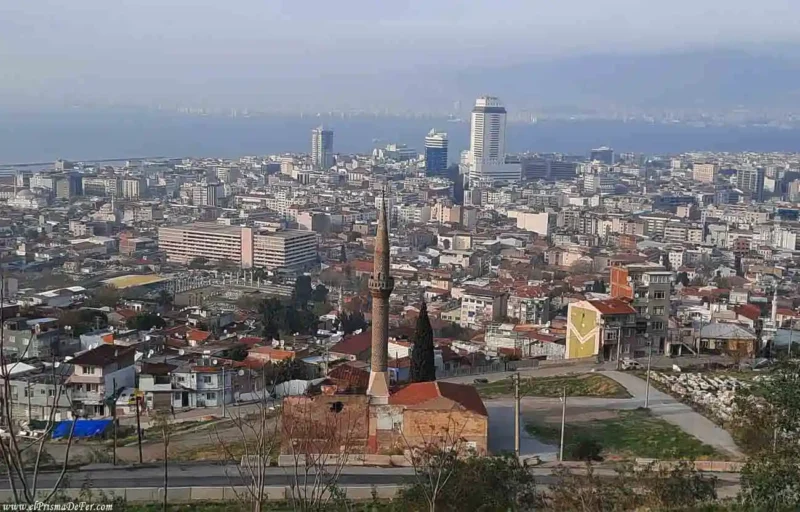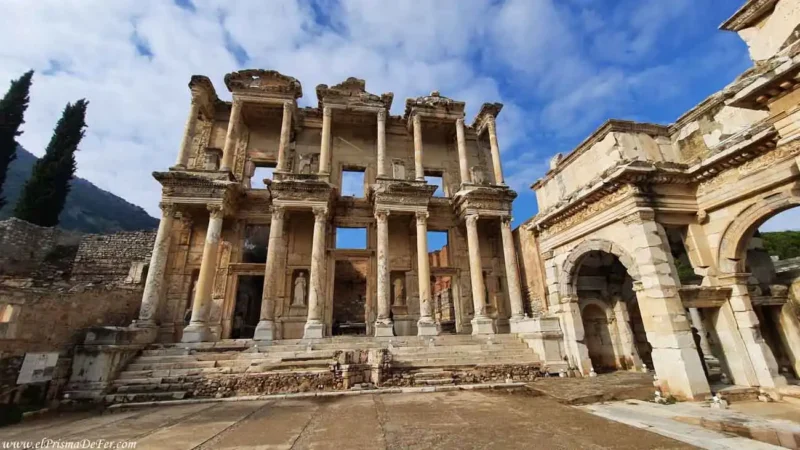Visiting Pamukkale was like entering a landscape from another planet, once again surprising me with Türkiye. From a distance, the white hill looks like a snow-capped mountain in the middle of the arid southwestern landscape, but when you get closer, you realize that what's shining in the sun isn't snow, but something else.
But beyond the natural beauty, what caught my attention was that just above the “cotton castle” are the ruins of Hierapolis, an ancient Roman city that flourished thanks to the same hot springs that today attract travelers from all over the world.
In this post, I'll tell you everything you need to know to visit this dreamy corner of Turkey and make the most of your time in one of the country's most stunning landscapes.
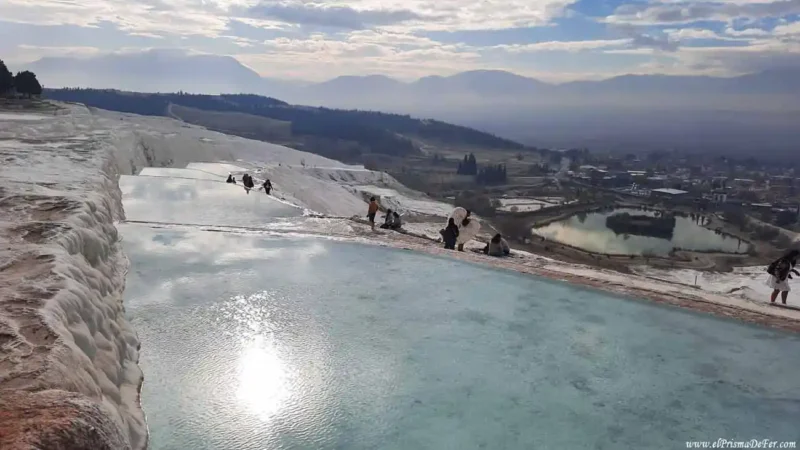

Table of Contents
What is Pamukkale and how was it formed?
Pamukkale, whose name in Turkish means “cotton castle” is one of Turkey's most impressive natural phenomena. What at first glance looks like a snow-covered mountain is actually travertine terraces, formed by the accumulation of minerals brought by the thermal water.
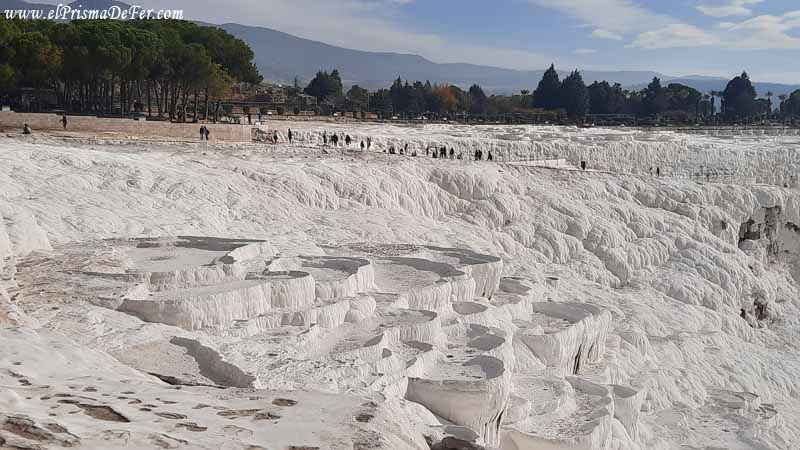
For thousands of years, these calcium carbonate-rich waters flowed down the hillside, slowly cooling and depositing white layers that formed the natural pools that today look like they were sculpted by artists.
In addition to its beauty, Pamukkale has enormous historical value: since Roman times, people have been coming here, attracted by the healing properties of its waters.
In fact, just above the valley was founded the ancient city of Hierapolis, a spa centre that became one of the most important of the Roman Empire in Asia Minor.
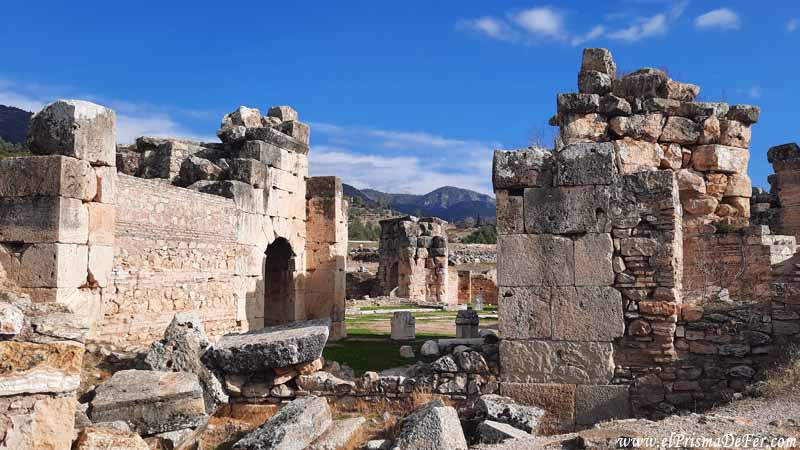
Where is Pamukkale located?
Pamukkale is located in southwest Turkey, within the Denizli province, in the Aegean region.
It is located approximately 20 kilometers from the city of Denizli, which serves as the main connection point to the rest of the country. From there, it can be easily reached by minibus or taxi in less than half an hour.
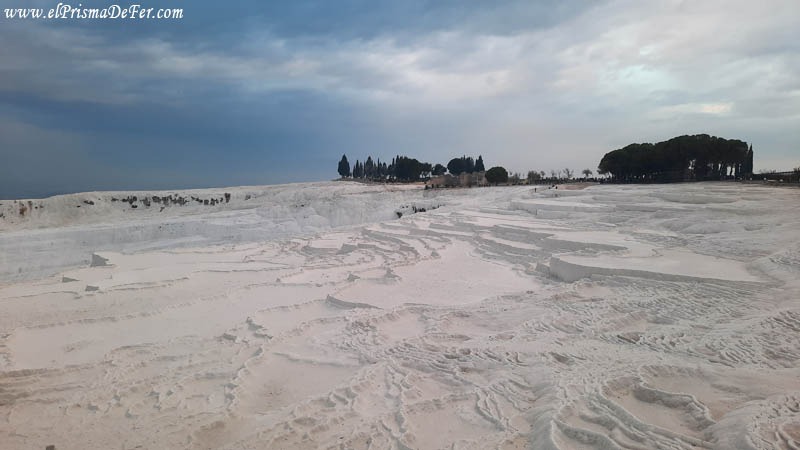
The area is strategically located between some of Turkey's most visited destinations: it is about 3 and a half hours from Antalya, 4 hours from Izmir and around 10 hours from Istanbul.
Its location makes it an ideal stop on a route through the south or west of the country, especially if you're traveling between the Mediterranean coast and the landscapes of Cappadocia.
How to get to Pamukkale
If you're coming from Istanbul, you can take a direct flight to Denizli Çardak Airport, which is about 65 km from Pamukkale, or an overnight bus that takes 10 to 11 hours. From the airport or Denizli bus terminal, there are minibuses that connect directly to Pamukkale.
From Ankara, the most comfortable option is also the bus, with a journey time of approximately 7 hours, or trains that go to Denizli and then connect with local transport to Pamukkale.
If you are coming from Antalya, there may not be a direct bus to Pamukkale. In that case, it is best to take a bus to Denizli. Once you arrive, you'll find minibuses to Pamukkale inside the terminal. They usually leave from the station's basement, although if you have any questions, you can ask anyone who will be able to guide you.
The final journey is short, about 20 to 25 minutes, and drops you off right in the village, just a few steps from the entrance to the white terraces. To return to Denizli, you can wait for the minibuses at this stop I've marked on the map.
To organize your bus journeys, the most practical application is Obilet, very popular in Türkiye, which allows you to check schedules, compare companies and reserve seats directly from your cell phone.
What is the town like?
The town of Pamukkale is small and quiet, but it is not a particularly picturesque destination beyond its proximity to the terraces and Hierapolis.
Budget accommodation is limited, and I couldn't find a hostel during my visit. I ended up staying at a hotel called Aspawa Hotel, which, while fine for a one-night stay, reflects the fact that most options are expensive hotels with hot springs, spas, and pools, rather than places to stay for backpackers on a budget.
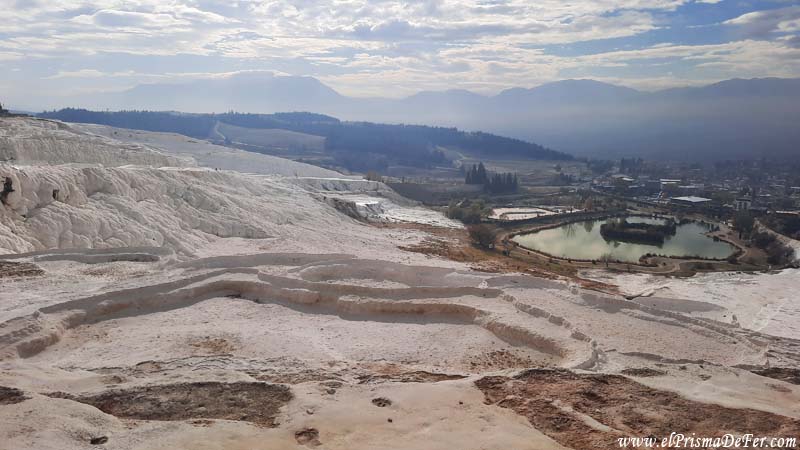
Additionally, many visitors arrive at Pamukkale on day tours from nearby cities such as Antalya, Selçuk, or even Izmir, and do not stay overnight in the town.
This causes most people to tour the complex for a few hours and then return to their hometown, which can give the impression that the place is packed with tourists concentrated in short periods of the day.
Despite this, the town serves its purpose: it's the starting point for visiting the terraces and the old city, with a few restaurants and basic shops where you can refill your water, buy snacks, or buy souvenirs. But if you're looking for nightlife, bars, or something more lively, you won't find it here.

Map of the Pamukkale complex
Where to enter the complex
The complex has several entrances, although the most popular is right in front of the village (see on map), where most minibuses and taxis arrive.
Additionally, it can be accessed from the upper entrance near Hierapolis (see on map) or from the northern sector (see on map).
Entering through these less crowded areas is a practical option if you want to avoid crowds or directly approach certain areas of the terraces or Hierapolis from different points.
What to see in Pamukkale
The entrance to the Pamukkale complex includes both the famous travertine terraces and the ruins of the ancient city of Hierapolis, which are located just at the top of the hill.
Both are part of the same UNESCO World Heritage Site, so you can visit both attractions with just one ticket.
The travertine terraces
The visit begins at the base of the hill, where you enter barefoot to protect the fragile white travertine surface.
From there, you slowly ascend along a nature trail while you see channels of hot water running down, forming small crystal-clear pools that reflect the sky.
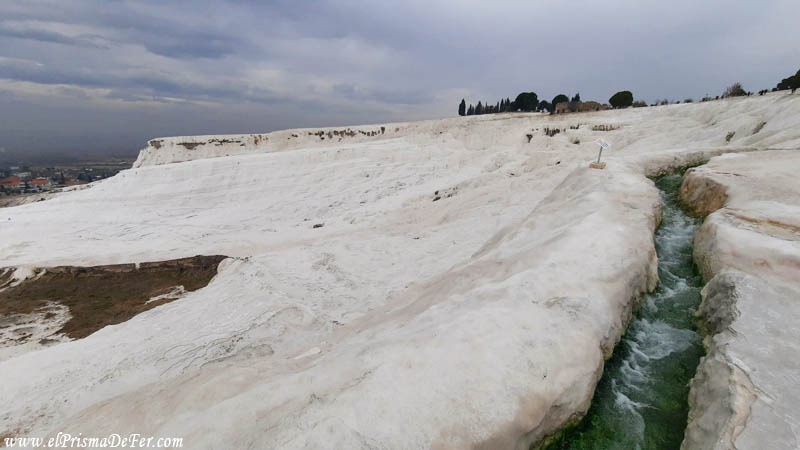
As you climb, natural viewpoints appear with spectacular views of the Denizli Valley, especially at sunset.
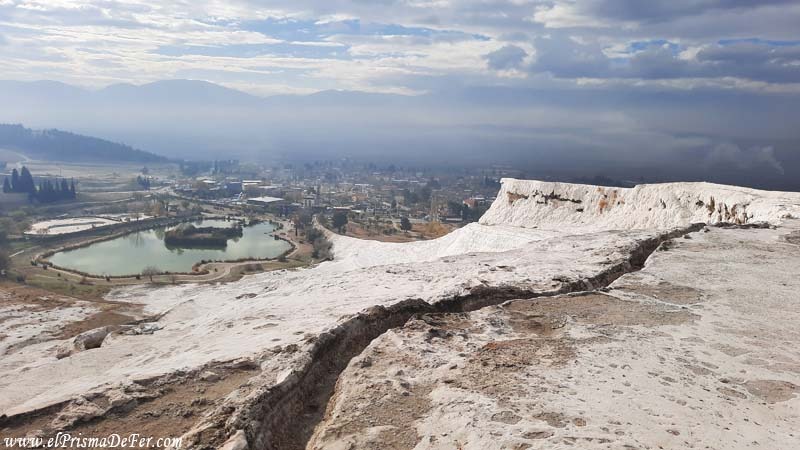
The sensation of walking on the terraces is quite peculiar. Walking barefoot on that rough white surface feels strange at first.
In some sections, the ground is so smooth and wet that it becomes very slippery, and I saw several people fall while trying to keep their balance.
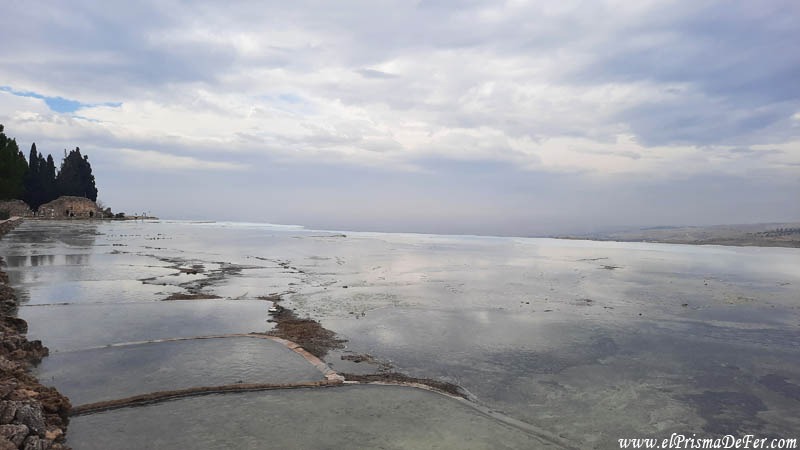
Still, every bend reveals new pools, some small and shallow, others larger where you can sit and enjoy the surroundings.
Why are several terraces dry?
When I visited Pamukkale, I was surprised to see that many of the terraces were completely dry. I'd always seen the perfect landscape in Instagram photos and videos, with all the pools filled with crystal-clear water, but the reality was quite different.
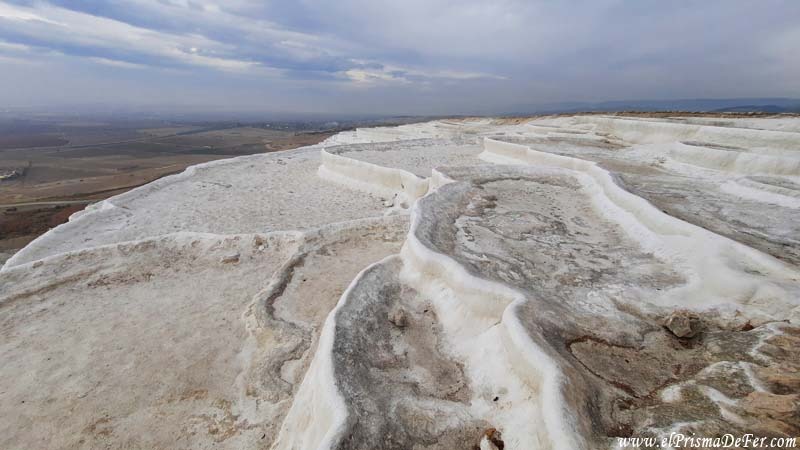
This is because for years several hotels in the area diverted the thermal water to their own pools, which significantly reduced the flow reaching the natural formations.
Currently, authorities have banned these practices or moved extraction sites further away to protect the local ecosystem.
The expectation is that, over time, the waters will refill the pools and Pamukkale will regain its completely white, bathed appearance, as we know it in the most famous photographs.
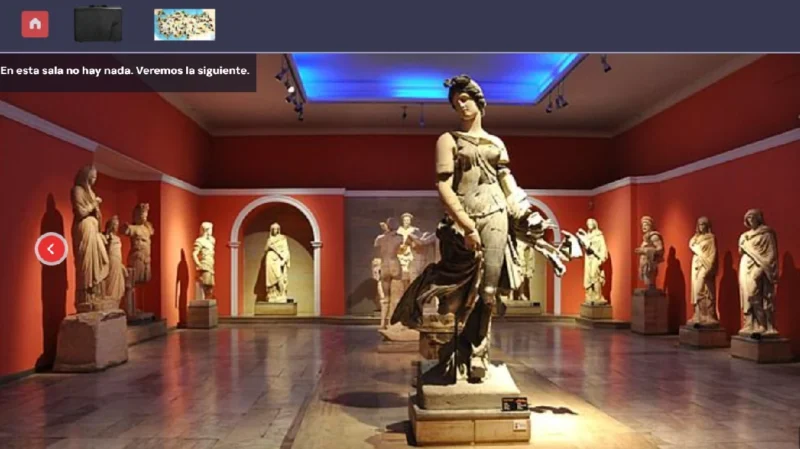
If you want to learn in a fun way, play the Turkey trivia, an interactive game with a variety of puzzles and a captivating story.
Hierapolis, the city above the clouds
Just above the white terraces of Pamukkale lie the ruins of Hierapolis, an ancient city founded by the kings of Pergamon in the 2nd century BC and later incorporated into the Roman Empire.
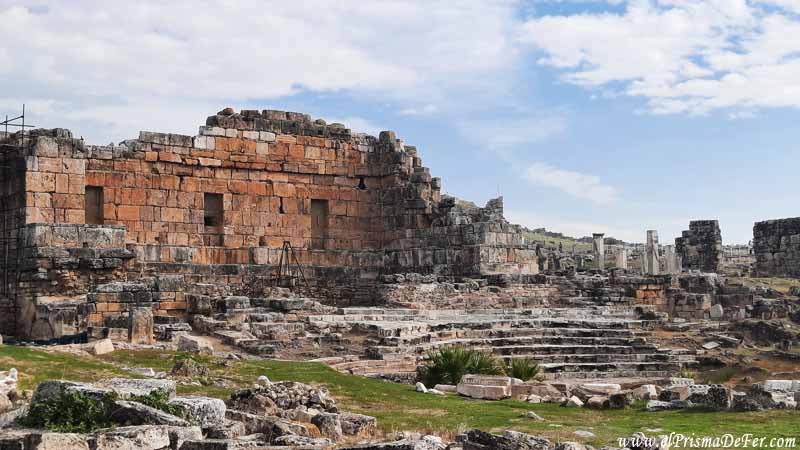
For centuries, it was an important spa and religious center, famous for its healing waters and as a resting place for nobles, the sick, and pilgrims who came from all corners of Asia Minor.
Today, its remains blend with the landscape and terraces, creating a scene unique in the world.
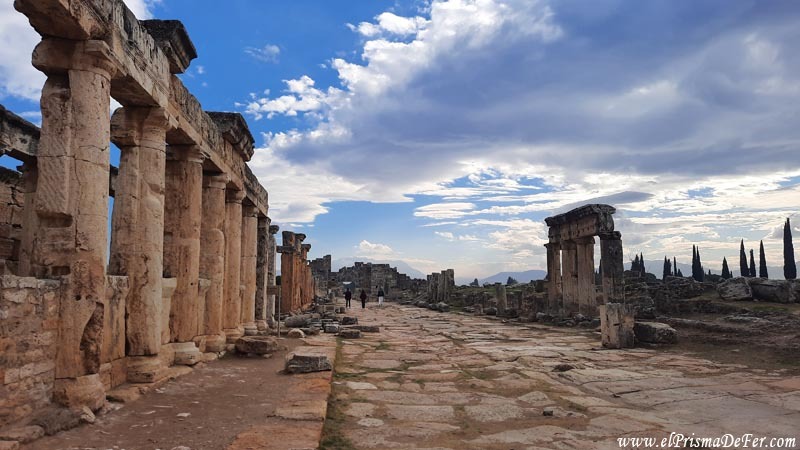
Roman amphitheater
Among the highlights of the visit is the surprisingly well-preserved Roman amphitheater, with a capacity for more than 12,000 people and a panoramic view of the surrounding valley.
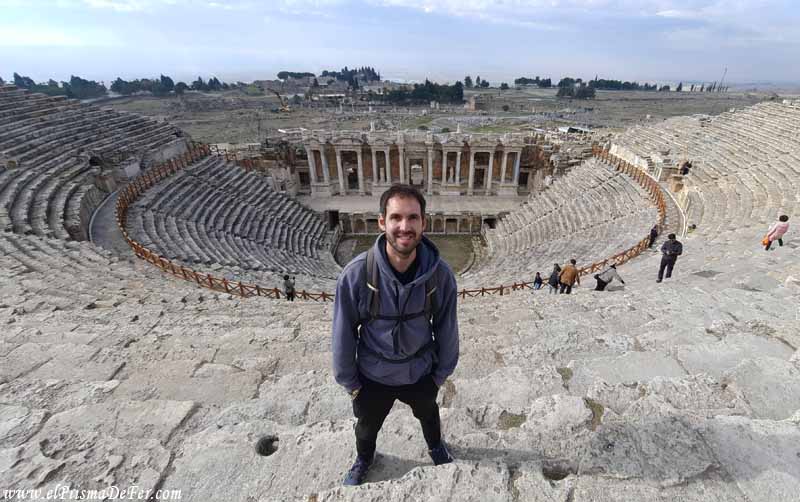
Necropolis
Also worth a visit is the necropolis, one of the largest in Anatolia, with hundreds of tombs and stone sarcophagi that tell the story of a prosperous and spiritual city.
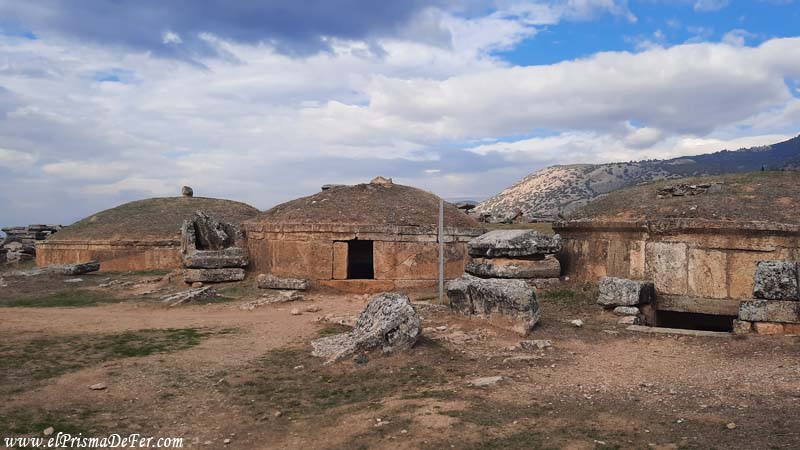
Cleopatra's Pool
The Cleopatra's Pool, a thermal pool where, according to legend, the Egyptian queen herself bathed to preserve her youth, is another must-see.
Today you can swim among ancient columns and marble remains that fell after an earthquake, in waters at around 36°C that continue to flow from the same mineral spring.
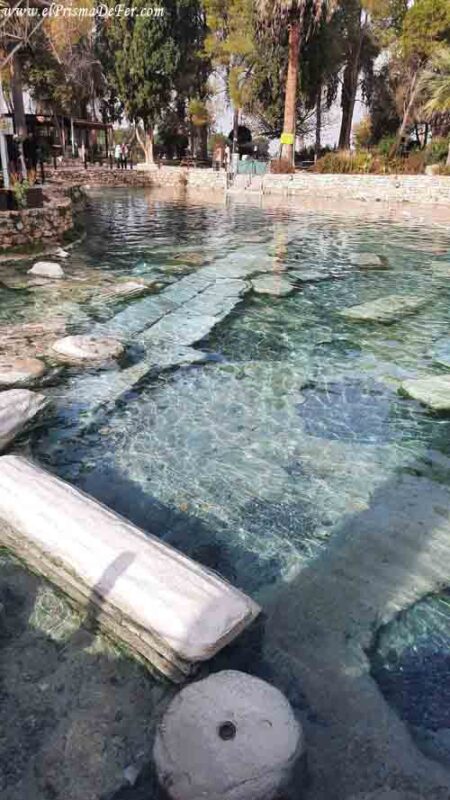
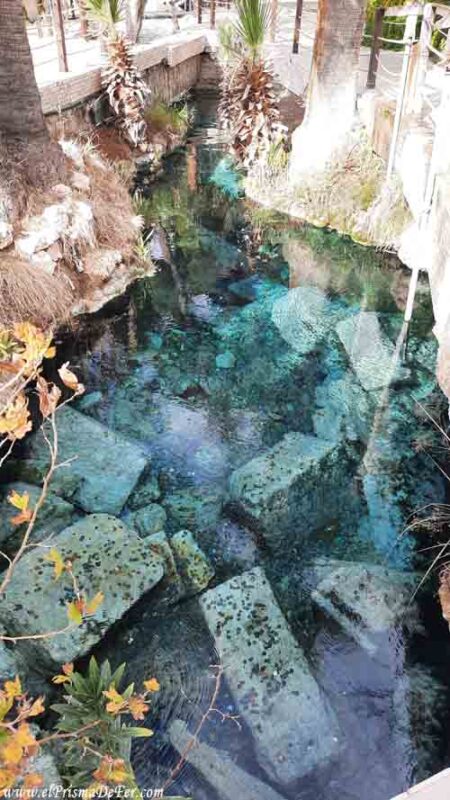
It's important to note that access to this pool has a separate cost from the main complex, so it's a good idea to keep this in mind when planning your visit.
Main street of Hierapolis
Another notable site in Hierapolis is the remains of the city's main street, which preserves several columns and large monumental entrances.
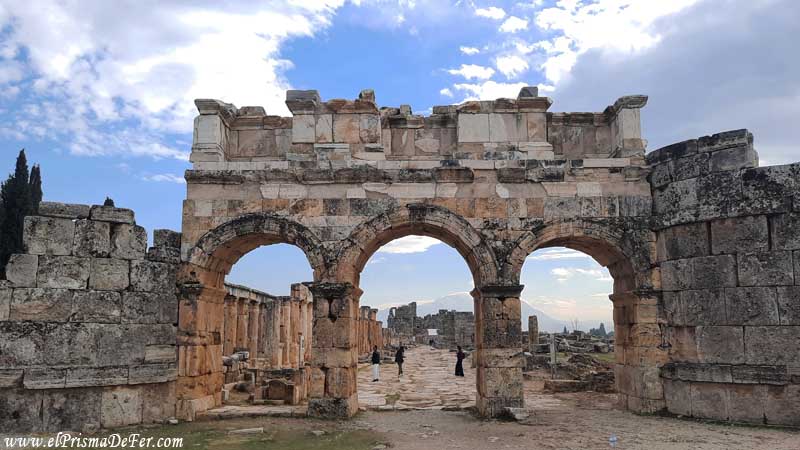
Walking along this ancient urban axis made me step back in time and imagine what daily life was like for the inhabitants, with markets, temples, and public buildings lining the road, and I appreciated the impressive preservation of many of its structures.
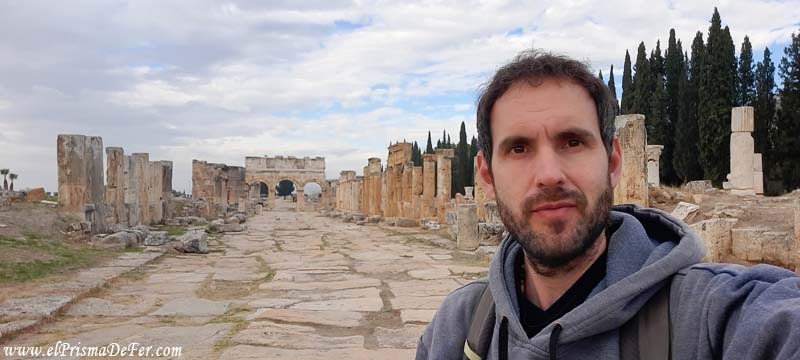
Pamukkale Archaeological Museum
Inside Hierapolis is the Pamukkale Archaeological Museum, housed in what was once an ancient Roman bathhouse.
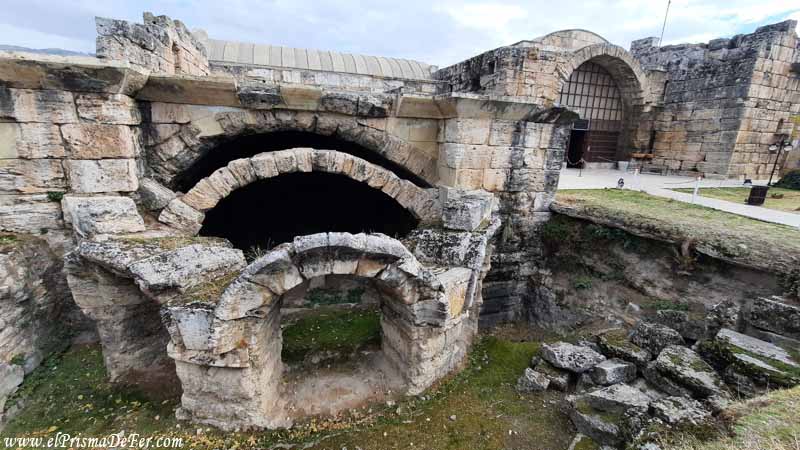
Inside, sculptures, sarcophagi, reliefs and objects found in excavations at Hierapolis, Laodicea and other nearby cities are exhibited.
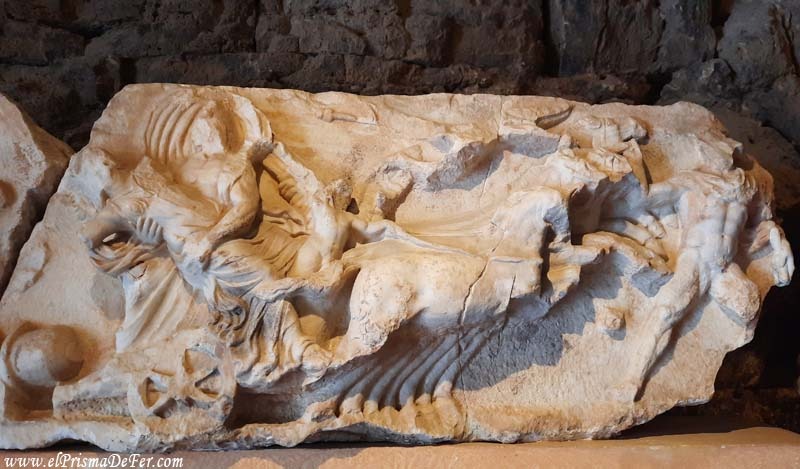
It's a short but very interesting visit to understand the history and cultural richness of this region, which in ancient times was an important spa and religious center.
There is no extra entry fee.
Balloon ride
In recent years, Pamukkale has joined the Cappadocia trend, and hot air balloon rides have become increasingly popular.
The flight usually takes place at dawn, when the sunlight paints the terraces in golden tones, creating a visual spectacle that many describe as magical (I didn't do it since I had gone to the one in Cappadocia).
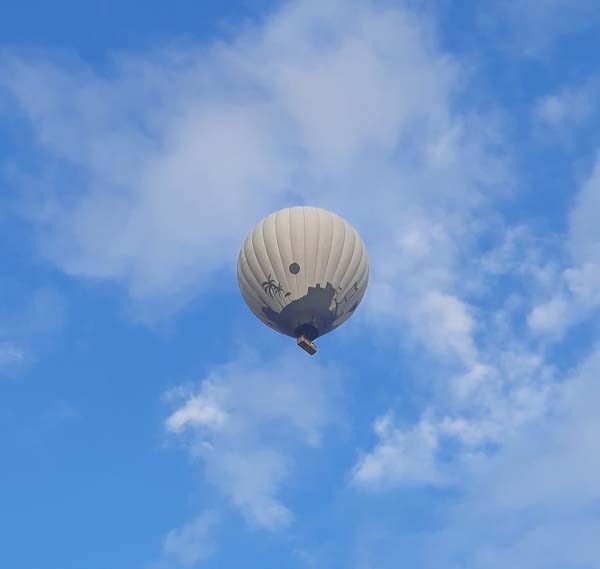
Although it's not cheap—prices typically range from €100 to €200 per person—for those looking for a unique experience and unforgettable views, it's an option worth considering.
While balloon rides offer incredible views of the terraces and Hierapolis, unlike in Cappadocia, there aren't many balloons in the sky at once, which takes some of the excitement out of the experience.

Tickets, prices and practical tips
Entrance and entry times
The entrance to the Pamukkale complex includes both the famous travertine terraces and the ancient city of Hierapolis, so with a single ticket you can visit both.
Prices may vary depending on the season and payment method, but the general ticket is around 30 euros, while access to the Cleopatra's Pool is additional, around 10 euros extra, since it allows you to swim among the ancient columns and enjoy the thermal waters at around 36°C.
For updated prices and opening hours, please visit the official website of the complex.
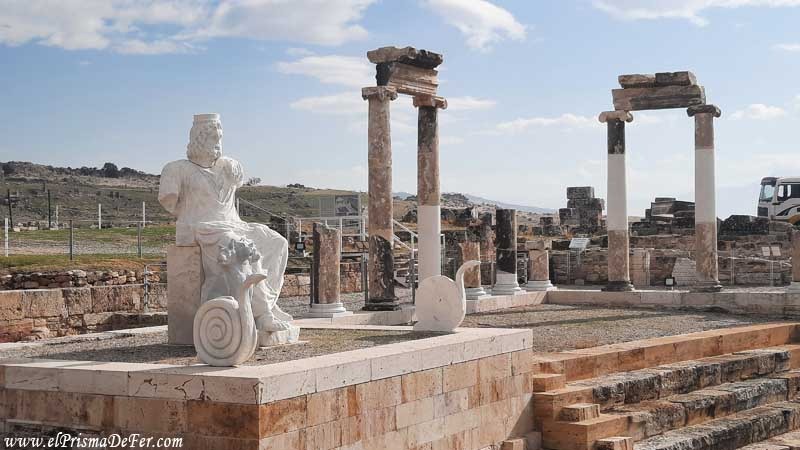
Tips for visiting Pamukkale
Some practical tips to make the most of your visit:
- You'll have to go barefoot on the terraces: To protect the travertine stones, footwear is not permitted inside the pool area. For the rest of the complex, walking is fine.
- Avoid peak hours: Early morning or late afternoon is when there are fewer people and the light makes the terraces look spectacular.
- Bring water and snacks: Although there are areas to eat and drink within the complex, prices are usually higher than in town.
- Visit time: To explore the terraces and Hierapolis at a leisurely pace, it is advisable to dedicate 3-4 hours.
The best time to visit Pamukkale
The best time to visit Pamukkale is from spring to early autumn, roughly between April and October. During these months, the weather is pleasant, with mild temperatures and sunny days that allow you to fully enjoy the terraces and Hierapolis.
Summer can be very hot, especially in July and August, with temperatures exceeding 35°C, making walking on the terraces and the hike to Hierapolis more tiring.
On the other hand, winter is colder but less crowded. Although some pools may be colder, walking barefoot on the travertine may be less pleasant.
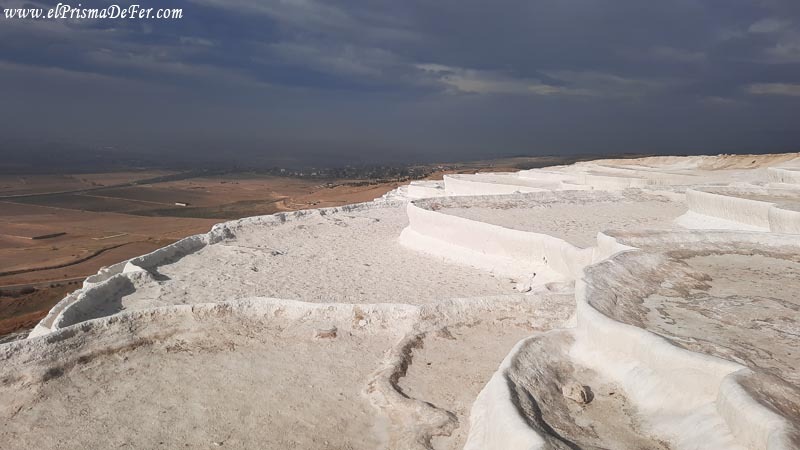
My final thoughts
I really liked Pamukkale. When I arrived, I was only expecting to see the famous travertine terraces I'd seen so often on Instagram. But the truth is that this is only half the attraction, what really completes the visit is touring Hierapolis, one of the largest and best preserved ruins in Turkey.
Walking through its streets, seeing the columns of the Agora, the amphitheater, and Cleopatra's Pool, all while having the brilliant white of the terraces in the background, makes the visit much richer and more complete than I initially imagined.
Pamukkale combines nature and history in a unique way, and although the town itself isn't spectacular and some of the pools are dry, the overall experience is totally worth it.
Support The Prism of Fer!
Your support helps me continue creating free content on the blog. Thank you so much!


